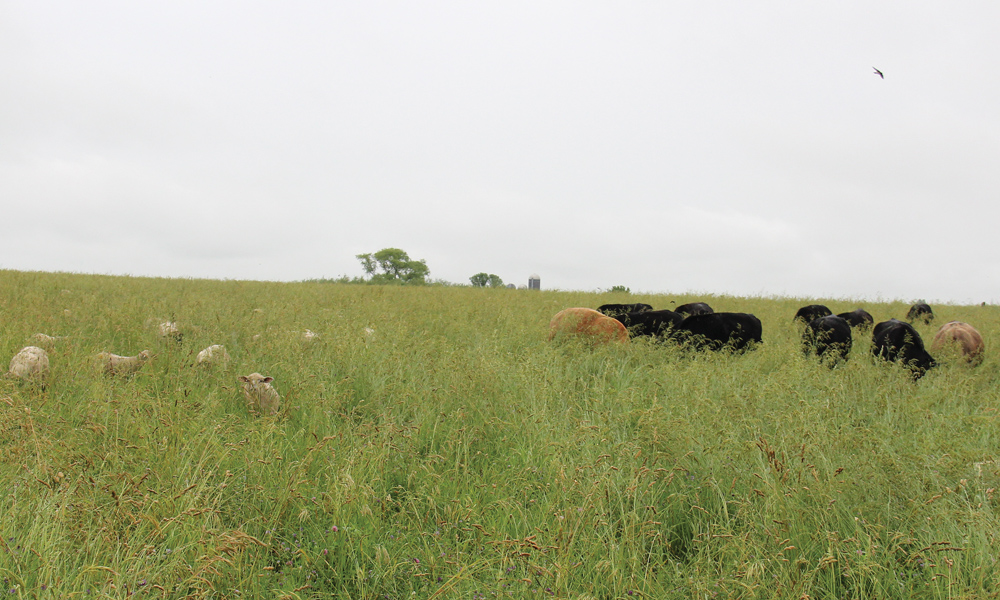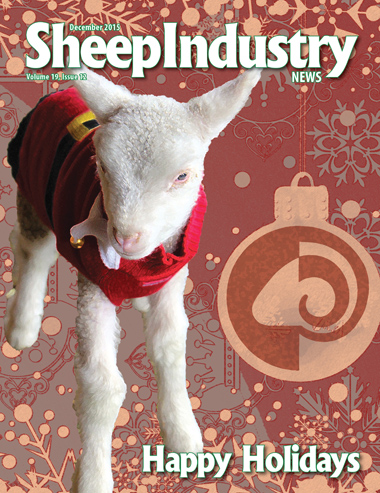Multi-Specis Grazing
Pasture Sheep, Cattle & Goats Together to Increase Profits
JESSE DUCKETT
Duckett Farms, Hope, Ark.
In the early 1900s, movies often portrayed the conflict between Western cattle and sheep ranchers. Cowboys and shepherds didn’t get along particularly well because the wisdom of the day was that sheep could not graze on the same grass or drink from the same creek as cattle.
 Many of today’s producers still feel the same way, and the problem is compounded by the fact that American farmers are growing older and often unwilling to consider making changes in their operations.
Many of today’s producers still feel the same way, and the problem is compounded by the fact that American farmers are growing older and often unwilling to consider making changes in their operations.
We have a challenge here, but also a corresponding opportunity to improve the stewardship of our land in more profitable and successful ways. Farmers, ranchers, universities, the United States Department of Agriculture and agricultural leaders need to team up and put away the generations old idea that sheep and cattle cannot graze together. Industry research has shown time and again that not only can sheep and cattle graze together, but also that this type of grazing program can improve the quality of your pasture – particularly if you’re grazing the ideal number of animals in a well-designed multi-species grazing program.
Multi-Species Grazing Resources
Anywhere you look, you’ll find a number of great resources on the subject of multi-species grazing. Linda Coffee, NCAT Agriculture Specialist in Fayetteville, Ark., for instance, has a great article on the subject. Her work shows that mixed-species grazing offers many advantages to farmers, not the least of which is fewer browsing plants and weeds, which allows for more grass growth. Goats, in particular, prefer browsing on brush – they’ll help you control blackberries, roses and many other weeds and plants found throughout your pasture.
Another great example of the research being done in this field comes from a group of South Dakota State University researchers – Ken Olson, Extension Beef Specialist, Roger Gates, Rangeland Management Specialist and David Ollila, Extension Sheep Specialist.
They started researching multi-species grazing in 2012, and South Dakota ranchers Dan and Sharon Anderson agree with their findings. The Andersons run both cattle and sheep on most of the 11,000-acre ranch that they manage and say that not only does this allow them to bring in profit from two livestock enterprises, but the sheep also keep noxious weeds and sage brush under control.
This study will determine the full effects of multi-species grazing on pasture quality and quantity, and it will shed light on the ideal number of cattle and sheep for a balanced multi-species grazing program.
You’ll find many more great resources online, both for grazing sheep, goats and cattle together and for grazing just sheep and cattle. If you want to read a number of great articles, search for the following people online:
• Mark Kennedy, Grazing Land Specialist, Missouri State University
• Rocky Lemus, Extension Forage Specialist, Mississippi State University
• Susan Sehoenian, Sheep and Goat Specialist, University of Maryland, SheepAndGoat.com
So how does multi-species grazing work? Sheep tend to prefer grass, and they are also quite effective at controlling weeds. For the most part, sheep will graze near to the ground while cattle graze on taller grasses.
It’s been said before that sheep will graze around cow manure piles, which cattle will reject. This is an inexpensive way to clean out your pasture and encourage more grass. The pasture’s feeding capacity will increase as it starts producing higher quality grasses and more pounds of feed per acre. You’ll be able to pasture more animals per acre and reap greater profits.
Are these the results that you can expect from multi-species grazing?
Current research and opinions vary, but in general, if you start small when adding new animals to your operation and grow your multi-species grazing program slowly, you can expect to improve your pasture and increase your farm income while allowing sheep and goats to control the weeds. Of course, this will require a little more management and some new investments in facilities – fences and sheds – but multi-species grazing will provide you with a big payoff.
Parasites
Parasites are a major problem for livestock producers, and it’s a problem that increases with time as parasitic cycles repeat. In addition, high concentrations of animals sometimes magnify the infestation. We have both cattle parasites and sheep and goat parasites. Cattle tend to act as vacuum cleaners, lowing the sheep and goat worm larvae and thereby preventing them from affecting the sheep and goats – a major advantage when sheep, goats and cattle are grazing the same pasture.
Goats and sheep, on the other hand, share many of the same parasites, so grazing them together without cattle doesn’t help you to control pasture parasites.
Predators
Grazing sheep and cattle together has been shown to reduce predator losses, but in order for mixed species grazing to be an effective deterrent to predators, cows and sheep must bond together.
When bonded sheep and cattle are turned out to pasture, the sheep will follow the cattle. Then, when threatened by predators, the sheep tend to run to the cattle and huddle amongst them. Pairing sheep and cattle reduces predator losses because the cattle are much larger and tend to be more aggressive.
The Future
Another factor to consider is the kind of pasture available on your farm or ranch. In southwestern Arkansas, well-fertilized Bermuda grass is excellent from May throughout August. On such a pasture, you can run seven to 10 ewes per acre or three to four ewes and one cow as a grazing unit. Goats, however, do not eat grass as well as sheep and cattle – they prefer to browse on the brush and weeds in your pasture.
When it comes to lambing, your ewes will be able to lamb on pasture or in an acre lot around your barns. Just like cows calving in the spring, you can expect lambs from March through May. Those lambs will be ready for market in October through December.
If you have a 150 percent lamb crop while you’re running 100 head of ewes, you’ll have 150 lambs weighing around 70 pounds each. At $1 per pound or $70 per head, that’s a total of $10,500 or $105 per ewe. If they sell for $2 per pound, the profit doubles.
Those numbers prove that the sheep industry has a bright future in Arkansas. By using outdated farm buildings for lambing and feeding, you’ll have a low investment in your flock of ewes. Just look at the cost of cattle – for the cost of one cow, you can buy 10 ewes. You can also create a year-round supply of lamb by using an out-of-season breeding program (three lambings in 24 months). This method is becoming very popular in the Canadian sheep industry. In fact, Canadian producers are starting 2,500-head ewe farms that utilize out-of-season breeding programs.
Small landowners can easily raise sheep and goats, and this industry could boost agricultureal income in many southern states. Arkansas definitely has the markets to sell sheep and goats – there are three or four sale barns in the state, and a USDA-bonded sheep and goat buying station. The station’s market prices in Hope, Ark., are in line with the Texas markets. In the fall of this year, No. 1 (45-60 lbs) lambs were selling for around $2.10 per pound. We need to educate cattlemen and farmers across the South so that they understand how sheep can not only improve farm incomes, but also help grow a brighter future for livestock producers.


